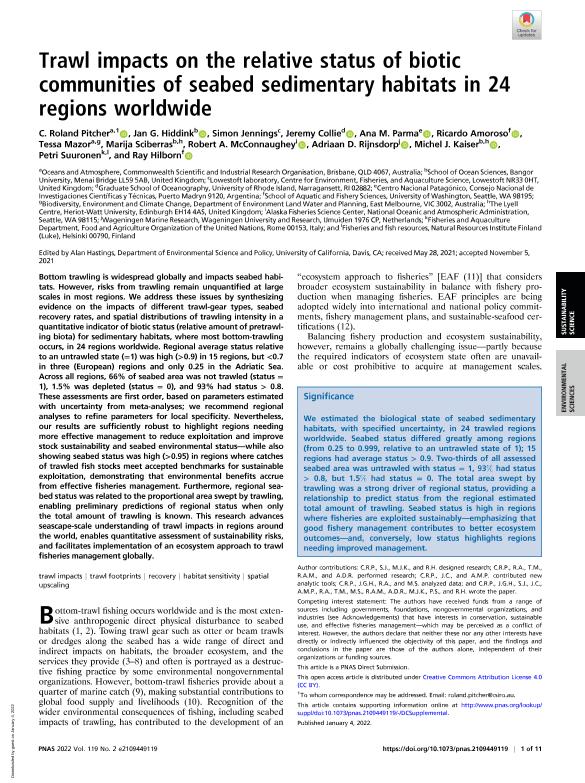Mostrar el registro sencillo del ítem
dc.contributor.author
Pitcher, Clifford Roland

dc.contributor.author
Hiddink, Jan G.
dc.contributor.author
Jennings, Simon
dc.contributor.author
Collie, Jeremy
dc.contributor.author
Parma, Ana María

dc.contributor.author
Amoroso, Ricardo Oscar

dc.contributor.author
Mazor, Tessa
dc.contributor.author
Sciberras, Marija
dc.contributor.author
McConnaughey, Robert A.
dc.contributor.author
Rijnsdorp, Adriaan D.
dc.contributor.author
Kaiser, Michel J.
dc.contributor.author
Suuronen, Petri
dc.contributor.author
Hilborn, Ray
dc.date.available
2023-07-25T20:51:15Z
dc.date.issued
2022-01
dc.identifier.citation
Pitcher, Clifford Roland; Hiddink, Jan G.; Jennings, Simon; Collie, Jeremy; Parma, Ana María; et al.; Trawl impacts on the relative status of biotic communities of seabed sedimentary habitats in 24 regions worldwide; National Academy of Sciences; Proceedings of the National Academy of Sciences of The United States of America; 119; 2; 1-2022; 1-11; e2109449119
dc.identifier.issn
0027-8424
dc.identifier.uri
http://hdl.handle.net/11336/205488
dc.description.abstract
Bottom trawling is widespread globally and impacts seabed habitats. However, risks from trawling remain unquantified at large scales in most regions. We address these issues by synthesizing evidence on the impacts of different trawl-gear types, seabed recovery rates, and spatial distributions of trawling intensity in a quantitative indicator of biotic status (relative amount of pretrawling biota) for sedimentary habitats, where most bottom-trawling occurs, in 24 regions worldwide. Regional average status relative to an untrawled state (=1) was high (>0.9) in 15 regions, but <0.7 in three (European) regions and only 0.25 in the Adriatic Sea. Across all regions, 66% of seabed area was not trawled (status = 1), 1.5% was depleted (status = 0), and 93% had status > 0.8. These assessments are first order, based on parameters estimated with uncertainty from meta-analyses; we recommend regional analyses to refine parameters for local specificity. Nevertheless, our results are sufficiently robust to highlight regions needing more effective management to reduce exploitation and improve stock sustainability and seabed environmental status—while also showing seabed status was high (>0.95) in regions where catches of trawled fish stocks meet accepted benchmarks for sustainable exploitation, demonstrating that environmental benefits accrue from effective fisheries management. Furthermore, regional seabed status was related to the proportional area swept by trawling, enabling preliminary predictions of regional status when only the total amount of trawling is known. This research advances seascape-scale understanding of trawl impacts in regions around the world, enables quantitative assessment of sustainability risks, and facilitates implementation of an ecosystem approach to trawl fisheries management globally.
dc.format
application/pdf
dc.language.iso
eng
dc.publisher
National Academy of Sciences

dc.rights
info:eu-repo/semantics/openAccess
dc.rights.uri
https://creativecommons.org/licenses/by/2.5/ar/
dc.subject
HABITAT SENSITIVITY
dc.subject
RECOVERY
dc.subject
SPATIAL UPSCALING
dc.subject
TRAWL FOOTPRINTS
dc.subject
TRAWL IMPACTS
dc.subject.classification
Pesca

dc.subject.classification
Agricultura, Silvicultura y Pesca

dc.subject.classification
CIENCIAS AGRÍCOLAS

dc.title
Trawl impacts on the relative status of biotic communities of seabed sedimentary habitats in 24 regions worldwide
dc.type
info:eu-repo/semantics/article
dc.type
info:ar-repo/semantics/artículo
dc.type
info:eu-repo/semantics/publishedVersion
dc.date.updated
2023-07-10T10:41:29Z
dc.identifier.eissn
1091-6490
dc.journal.volume
119
dc.journal.number
2
dc.journal.pagination
1-11; e2109449119
dc.journal.pais
Estados Unidos

dc.journal.ciudad
Washington DC
dc.conicet.avisoEditorial
This open access article is distributed under Creative Commons Attribution License 4.0 (CC BY)
dc.description.fil
Fil: Pitcher, Clifford Roland. Commonwealth Scientific And Industrial Research Organization; Australia
dc.description.fil
Fil: Hiddink, Jan G.. Bangor University; Reino Unido
dc.description.fil
Fil: Jennings, Simon. Centre for the Environment Fisheries and Aquaculture Science; Reino Unido
dc.description.fil
Fil: Collie, Jeremy. University of Rhode Island; Estados Unidos
dc.description.fil
Fil: Parma, Ana María. Consejo Nacional de Investigaciones Científicas y Técnicas. Centro Científico Tecnológico Conicet - Centro Nacional Patagónico. Centro para el Estudio de Sistemas Marinos; Argentina
dc.description.fil
Fil: Amoroso, Ricardo Oscar. University of Washington; Estados Unidos. Consejo Nacional de Investigaciones Científicas y Técnicas; Argentina
dc.description.fil
Fil: Mazor, Tessa. Commonwealth Scientific And Industrial Research Organization; Australia. State Government Of Victoria. Department Of Environment, Land, Water And Planning; Australia
dc.description.fil
Fil: Sciberras, Marija. Bangor University; Reino Unido. Heriot-Watt University; Reino Unido
dc.description.fil
Fil: McConnaughey, Robert A.. National Ocean And Atmospheric Administration; Estados Unidos
dc.description.fil
Fil: Rijnsdorp, Adriaan D.. Wageningen University and Research; Países Bajos
dc.description.fil
Fil: Kaiser, Michel J.. Bangor University; Reino Unido. Heriot-Watt University; Reino Unido
dc.description.fil
Fil: Suuronen, Petri. Food and Agriculture Organization of the United Nations; Italia. Natural Resources Institute; Finlandia
dc.description.fil
Fil: Hilborn, Ray. University of Washington; Estados Unidos
dc.journal.title
Proceedings of the National Academy of Sciences of The United States of America

dc.relation.alternativeid
info:eu-repo/semantics/altIdentifier/doi/http://dx.doi.org/10.1073/pnas.2109449119
dc.relation.alternativeid
info:eu-repo/semantics/altIdentifier/url/https://www.pnas.org/doi/full/10.1073/pnas.2109449119
Archivos asociados
